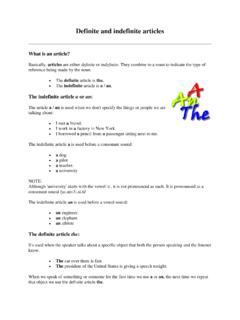Transcription of THE NEUROBIOLOGY OF EMOTION
1 EMOTION 929 THE NEUROBIOLOGY OF EMOTION Neural systems, the amygdala, and fear Is EMOTION a magic product, or is it a physiologic process which depends on an anatomic mechanism? Papez, 1937 Throughout the day, we experience a variety of emotions. For the most part, these emotions are transient in nature. However, when these emotions become intense or are unremitting they can have very dramatic effects on our behavior. The depressive syndrome is an example of a state that is characterized by unrelenting sadness accompanied by a deficit in one s ability to derive pleasure from positive situations. William James proposed one of the first theories of EMOTION that attempted to relate experience of EMOTION to physiological functions. He tried to describe the human experience of EMOTION : Conceive of yourself, if possible, suddenly stripped of all the EMOTION with which your world now inspires you, and try to imagine as it exists, purely by itself, without your favorable or unfavorable, hopeful or apprehensive comment.
2 It will be almost impossible for you to realize such a condition of negativity and deadness. No one portion of the universe would then have importance beyond another; and the whole collection of its things and series of its events would be without significance, character, expression, perspective. Whatever of value, interest, or meaning our respective worlds may appear imbued with are thus pure gifts of the spectator's mind. The primary emotions are anger, fear, pleasure, sadness, and disgust. Emotions can be conceptualized in terms of their functional or adaptive (help us survive) significance. Negative emotions such as anger and fear may promote avoidance or defensive behavior whereas the positive EMOTION of pleasure may facilitate ingestive, exploratory, sexual, or novel-seeking behavior. Thus, emotions and feelings may serve to achieve homeostasis or to facilitate adaptive behavior and equilibrium.
3 Emotions can be elicited by external stimuli. However, the stimuli must have relevance or motivational significance in order to guide appropriate, adaptive behavior. Is the stimulus good, bad, or neutral? Does it evoke anger, fear, or pleasure? What are its previous associations, what does it predict, what is an appropriate reaction? This general concept of stimulus relevance is important in guiding behavior in many spheres: consummatory, sexual, reproductive, defensive, approach/avoidance and fight/flight. We typically view emotions as primitive and instinctive responses that are not associated with complex intellectual or cognitive functions. Certainly, key stimulus elements in the environment can trigger instinctive emotional responses (imagine confronting a large, threatening animal). However, cognitive-emotional interactions are extremely important in the elicitation of everyday emotions.
4 In primates and humans, the brain has a striking capacity to learn and remember the emotional significance of diverse stimuli and events. Furthermore, our cognitive capacity allows us to assign emotional valence to stimuli, and to change the value that was previously assigned to a stimulus. For example, a child may be initially fearful of dogs, but through positive experiences the child may eventually enjoy and approach them. As another example, EMOTION 930 imagine the emotions associated with a new relationship. Initially, seeing the person may evoke positive emotions of desire and happiness. However, after a nasty breakup, the same person could easily elicit emotions of anxiety, tension, and anger. This second example illustrates two important points. First, the sensory or perceptual analysis of the person is the same ( , this is Bob).
5 The physical expression of EMOTION may also be the same ( , racing heart, flushed sensations, increased breathing rate). Second, the emotional reaction to the stimuli depends on cognitive processing. In other words, the evaluation of the stimulus (the person) in conjunction with past experiences determines the feelings or the conscious experience of joy or anger. Studies of brain functions reveal that neural pathways exist for these important cognitive-emotional interactions. Brain systems in EMOTION The neural basis of EMOTION has been studied for over a century. Early explorations suggested that specific brain regions are involved in the expression of emotional behavior. Studies in the 30s and 40s showed that electrodes placed in the hypothalamus elicited widespread activation of the sympathetic nervous system as well as coordinated expression of defensive reactions or presumed feelings of pleasure.
6 In our examination of emotions, emphasis will be placed on the role played by the limbic system and the monoamine systems. Limbic system As you know from your earlier lectures, the limbic system (Fig. 1) was originally proposed to consist of interconnected subcortical structures with pathways to the hypothalamus. The limbic system was proposed to modulate the emotional quality of stimuli and support autonomic effector mechanisms associated with emotional states. A key limbic structure that has a critical role in emotional expression is the amygdala. The amygdala has an important role in evaluating the emotional valence of stimuli. Support for this view arises from extensive work done with lesions of the amygdala. For example, animals with amygdala lesions have difficulty learning associations between environmental stimuli and emotional states.
7 They may fail to learn that a stimulus predicts reward or danger, they may fall in social rank, or show decreased affiliative behavior. Damage to other limbic structures can also produce changes in emotional behavior. Fig. 1. Schematic drawing of limbic structures and their connections. EMOTION 931 It is important to note that an interaction exists between cortical brain regions and the limbic system. There are massive connections between cortical regions, particularly from the frontal and temporal lobes, to subcortical limbic structures (Fig. 2). The implication of these connections is that complex sensory information processing occurring in the cortex can directly influence the limbic system. Conversely, limbic processing can strongly influence higher-level cognitive integration occurring in the cortex.
8 Disconnection in the transmission of information between the cortical and subcortical limbic structures can have dire consequences. For example, patients with frontal lobe lesions show inappropriate emotional and social behavior in the absence of intellectual deficits. These patients might cry or laugh inappropriately, urinate in public, or use profanity. Fig. 2. Schematic diagram emphasizing the interactions between structures in the limbic system and cortical regions of the brain. Reciprocal connections exist between the prefrontal and temporal cortical areas, and both regions project extensively to different limbic structures. Therefore, the cortex has a strong influence on mechanisms governing emotional and autonomic responses. Limbic and brain stem regions may also influence the cortex via pathways through the thalamus (not shown), and via direct connections from the amygdala and hippocampus.
9 Monoaminergic systems (serotonin, norepinephrine, dopamine) The neural circuits and brain structures involved in emotions are modulated by a myriad of chemical neurotransmitters. The ascending monoamine systems have received considerable attention over the past several decades. These include the serotonin, norepinephrine, and dopamine systems. Prior to the discovery of neurotransmitters, researchers believed that a major ascending neural system was responsible for arousal of forebrain (epithalamus, thalamus, subthalamus) and telencephalon (cerebral cortex, basal ganglia and associated structures like the nucleus basilis of Meynert and the nucleus accumbens). This neural system used to be called the ascending reticular activating system, before the monoamines were characterized. It is believed that a balance among these systems (as well as other neurotransmitters) is necessary for normal emotional states and arousal.
10 Over the last three decades, the neurochemical basis of this ascending system was described and receptors identified. EMOTION 932 Fig. 3. The brain stem dopamine (DA) system (top), serotonin system (bottom left) and norepinephrine system (bottom right). Cell bodies of the dopamine system are located in the ventral tegmental area and substantia nigra and project to regions such as the basal ganglia, limbic system, and frontal and temporal cortex. The raphe nucleus contains serotonin cell bodies that project to all areas of the cerebral cortex, temporal lobe structures, (amygdala, hippocampus, hypothalamus), the midbrain as well as the cerebellum and sites in brain stem and spinal cord. Locus coeruleus cell bodies contain norepinephrine and innervate all areas of cortex, cerebellum and spinal cord. The Neural Substrates of Fear and Anxiety This class of EMOTION is elicited by threatening situations and it functions as an internal signal to alert the organism to potential danger.







